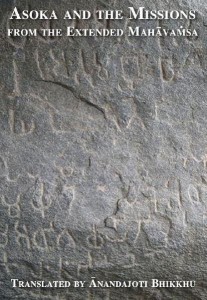 Asoka and the Missions. Asoka or Ashoka the Great, was an Indian emperor of the Maurya Dynasty. He ruled almost all of the Indian subcontinent from 269 BCE to 232 BCE. He embraced Buddhism after witnessing the Kalinga War, which he himself had waged. The Kalinga war had reportedly resulted in more than 100,000 deaths. This means it was one of the largest and bloodiest battles in ancient history. Ashoka thereafter regarded Buddhism as a doctrine that could serve as a cultural foundation for political unity. Therefore he initiated a series of Buddhist missions the far corners of his kingdom.
Asoka and the Missions. Asoka or Ashoka the Great, was an Indian emperor of the Maurya Dynasty. He ruled almost all of the Indian subcontinent from 269 BCE to 232 BCE. He embraced Buddhism after witnessing the Kalinga War, which he himself had waged. The Kalinga war had reportedly resulted in more than 100,000 deaths. This means it was one of the largest and bloodiest battles in ancient history. Ashoka thereafter regarded Buddhism as a doctrine that could serve as a cultural foundation for political unity. Therefore he initiated a series of Buddhist missions the far corners of his kingdom.
First full translation of Asoka and the Missions
This translation is done by Anandajoti Bhikkhu in 2012 and a lot of it has never been translated into English before. It expands on the original story with new information. The story begins with Asoka’s birth and follows his life through to his appointment as vice-sovereign in Avanti, his murdering of his 99 rival siblings and his ascendancy to the throne. His conversion is figured here with his initial dissatisfaction with the Brahmans his Father had supported, and the deep impression a young Buddhist monk makes on him. Having gained faith in the Buddha’s Dispensation, he quickly becomes one of its greatest supporters, building 84,000 monasteries in honor of the 84,000 sections of the Teaching and giving his children for ordination. The emphasis in the story then shifts away from Asoka and on to the various Missions, and especially to the one which was led by his son Mahinda to Sri Lanka. The story in this translation is brought to a close with the deaths, first of Asoka, then King Devanampiyatissa, followed by the Arahats Mahinda and Saṅghamittā and the other missionaries who followed them on their journey.
Download the free ebook here (83 pages/900 Kb):
 Asoka and the Missions
Asoka and the Missions
Ten facts about Asoka the Great
- Ashoka the Great was an Indian emperor who ruled from 269 to 232 BC.
- He was the third ruler of the Maurya dynasty, which was the first empire to rule over most of the Indian subcontinent.
- Ashoka is best known for his efforts to spread Buddhism throughout the world. He is considered one of the greatest kings in Indian history and is remembered for his military conquests, his support for Buddhism, and his commitment to non-violent governance.
- Ashoka was born into a royal family in present-day Bihar, India. His father was the Indian Emperor Bindusara.
- Ashoka was a military leader and conqueror early in his career. He expanded the Maurya Empire through military campaigns, including the conquest of the kingdom of Kalinga (present-day Odisha) in 261 BC.
- Ashoka’s conquest of Kalinga is considered a turning point in his life. It is said that the violence and suffering he witnessed during the war caused him to renounce violence and embrace Buddhism.
- Ashoka supported the spread of Buddhism through his empire and beyond. He sent missions to various parts of the world, including present-day Afghanistan, Sri Lanka, and Southeast Asia, to spread the teachings of the Buddha.
- Ashoka is known for his “rock and pillar edicts,” which were inscriptions on rocks and pillars throughout the Maurya Empire that outlined his moral and ethical beliefs. These edicts promote ideas such as non-violence, respect for all religions, and the importance of moral conduct.
- Ashoka is also known for his support of public works projects, such as the construction of hospitals, wells, and rest houses for travelers.
- After Ashoka’s death, the Maurya Empire began to decline, and it eventually collapsed in 185 BC. However, his legacy lived on through the spread of Buddhism and his ideas about non-violent governance.


Thank you, Lichtenberg.